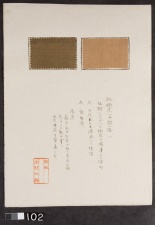Difference between revisions of "Hirugi /Tangara - right (102 R)"
Jump to navigation
Jump to search
(username removed) |
(username removed) |
||
| (One intermediate revision by the same user not shown) | |||
| Line 5: | Line 5: | ||
| 102 | | 102 | ||
|- | |- | ||
| − | ! scope="row"| | + | ! scope="row"|Uemura number / title |
| − | | | + | | ; "Haze-some 25" |
|- | |- | ||
! scope="row"|Folder location | ! scope="row"|Folder location | ||
| Line 44: | Line 44: | ||
| - | | - | ||
|- | |- | ||
| − | ! scope="row"| | + | ! scope="row"|Uemura's notes |
| Unlike Brazilwood or safflower, the dyestuff did not produce red color. Generally, lime water is used as mordant with this dyeing. | | Unlike Brazilwood or safflower, the dyestuff did not produce red color. Generally, lime water is used as mordant with this dyeing. | ||
|- | |- | ||
| − | ! scope="row"| | + | ! scope="row"|Uemura's date |
| Kyoto | | Kyoto | ||
|} | |} | ||
| − | [[Category: | + | [[Category:Uemura dye archive]] |
Latest revision as of 07:17, 24 July 2013
| Museum number | 102 |
|---|---|
| Uemura number / title | ; "Haze-some 25" |
| Folder location | 2nd shelf |
| Sample location | right (102 R) |
| Fiber type | silk |
| Color | light brown |
| Dyestuff (Japanese common name) | 紅樹 /丹殻 : Hirugi /Tangara |
| Dye (English common name) | Bruguiera |
| Dyestuff (botanical name) | Bruguiera gymnorrhiza (L.) Lam. |
| Plant part | bark /dried (?) |
| Dyestuff extraction | boiled in water |
| Auxiliary agent in dye bath | - |
| Mordant | lime water (supernate) |
| Other auxiliary agent | - |
| Uemura's notes | Unlike Brazilwood or safflower, the dyestuff did not produce red color. Generally, lime water is used as mordant with this dyeing. |
| Uemura's date | Kyoto |
